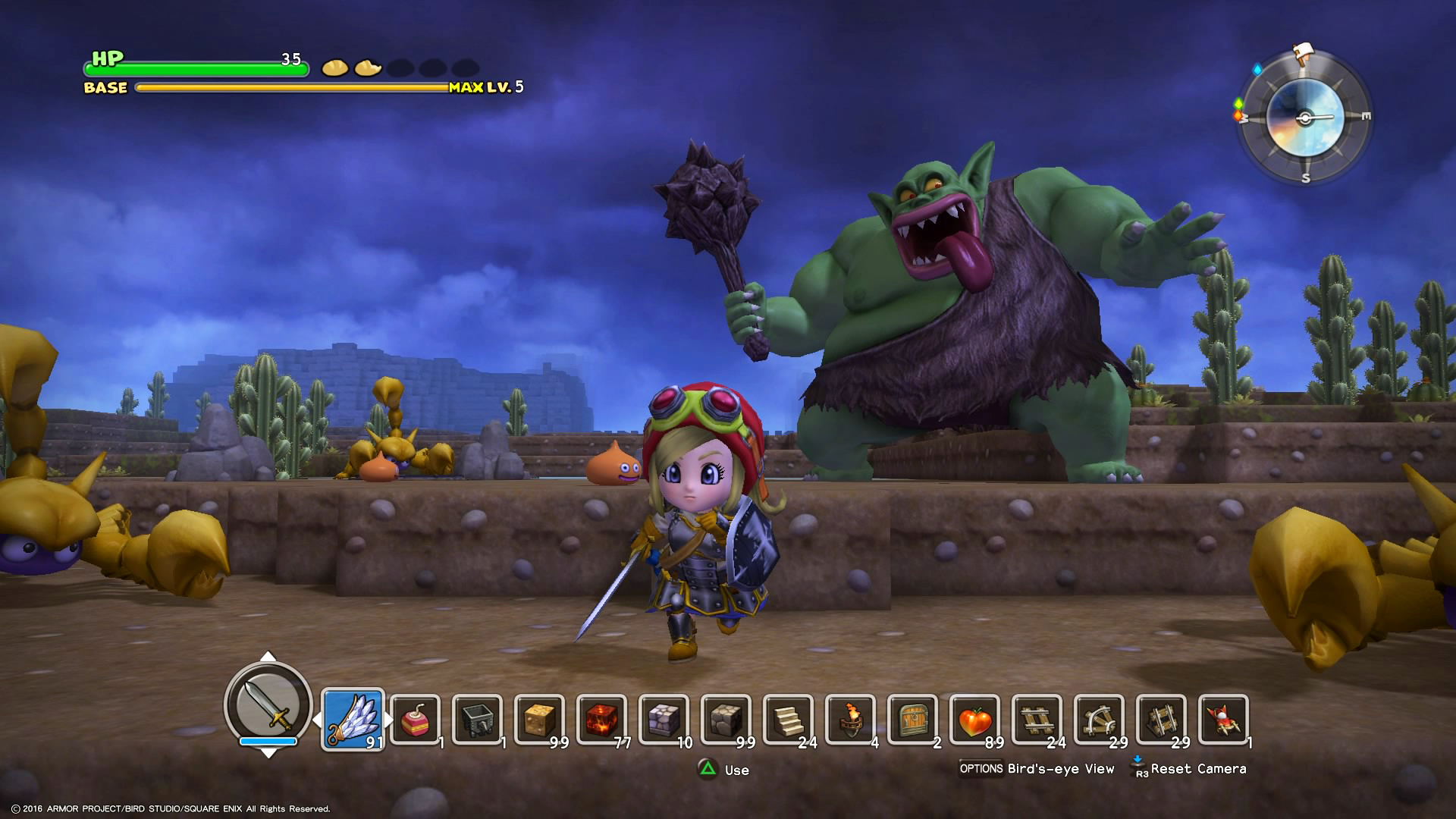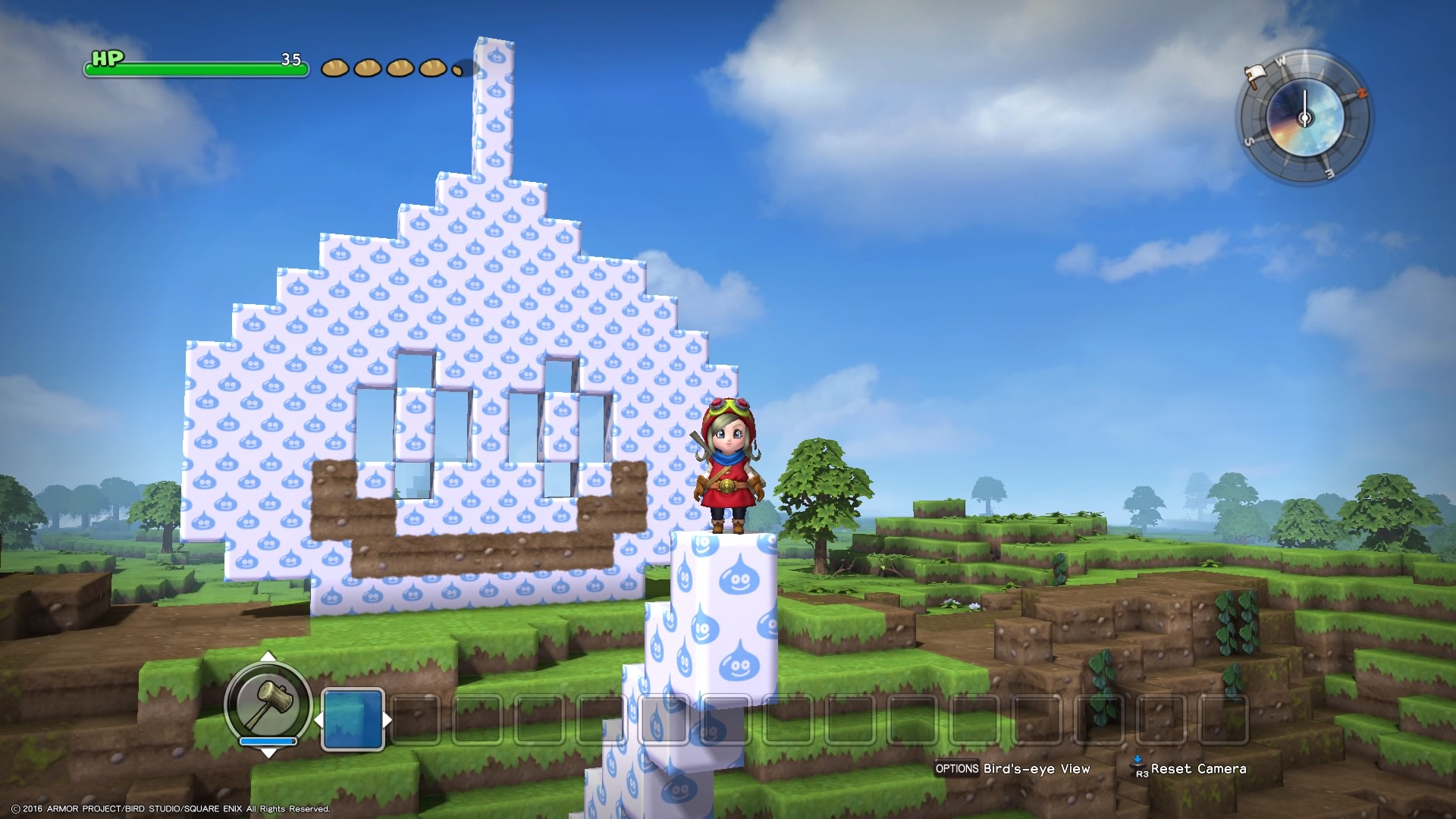
“Daddy, can we play your new Minecraft game again?”
That’s my four-year-old son, referring to a sneak peek version of Dragon Quest Builders I’ve been noodling with. He’s sitting in my lap as a I guide a twee medieval-ish Dragon Quest character around a cartoonish orthogonal cavern. I chip away at black or silver-flecked blocks, then Hoover up the goodies they leave behind. I’ll schlep these back to a crafting table where they’ll become walls, weapons, decorative items and more.
My son’s instinctive analogy to one of the most popular games in history says something important about publisher/developer Square Enix’s sandbox builder, due for PlayStation 3, 4 and PS Vita on October 11. But not what you think. Despite Dragon Quest Builders‘ superficial resemblance to studio Mojang’s magnum opus, it doesn’t play much like Minecraft at all.
Dragon Quest Builders‘ worlds aren’t procedurally dynamic
Minecraft‘s worlds are mathematically (though not randomly) generated from strings of characters called “seeds.” This, along with countless other algorithmic factors, ensures that each player’s world is uniquely arrayed, from bedrock to mountaintop.
By contrast, Dragon Quest Builders‘ worlds are fastidiously handcrafted (and apparently framed around the original Dragon Quest world of Alefgard). Everyone starts in the same spot, on the same landmass, with the same topographical features and spatial relationships to everything else. If Minecraft feels random in the sense that each seed generates a completely unique world (out of a total equal to the number two followed by 64 zeroes), Dragon Quest Builders‘ thoroughly designed and scripted areas feel anything but.

It melds delivered with emergent storytelling
Minecraft‘s story is whatever you did while playing it. You dug into a hillside to survive the night in a torchlit burrow. You replanted a bunch of flowers to spell your name. You stumbled into a hole that led to a dungeon that led to white-knuckle hours of exploration. Maybe you’re the bad guy wreaking havoc on unspoiled flatlands. Maybe Zombies, Spiders and Creepers are the world’s way of telling you to stop.
Dragon Quest Builders loads you up with walls of narrative text before you’ve so much as tiptoed an inch. There’s a big bad called the Dragonlord who at some point deconstructed the world into a monster-riddled wasteland. You’re the hero meant to revive the world (and gather together its scattered humans) by building stuff. And you learn how to do so by going on countless mini-quests to gather items or recipes or other people, each of these prefaced by bouts of exposition that add roleplaying flavor. It’s antithetical to Minecraft‘s silent, Rambo-like survivalist ethos.
And yet how you opt to solve a problem feels just as pliant and given to the unexpected, because it’s all about where you choose to gather resources, how prepared you were to do so and what you’ll run into—nomadic monsters, mysterious ruins (sometimes harboring quest-giving denizens), treasure chests and other distractions—along the way.
You can’t build whatever and wherever you like
Dragon Quest Builders initially directs you to the planning site for a town, then asks you to build structures and objects based on blueprints and recipes. You can vary certain attributes, like where things go, how many rooms should be residential or artisanal, how high to build things like walls and what types of material to build them out of. But it’s much more like a Sims game, where you’re operating within strictures to meet goals that generate points, in turn required to meet certain thresholds that advance the story.
This was true at least of the first chapter. My understanding is that the game has four chapters in all, not counting the open-ended “Terra Incognito” sandbox mode, where you can build whatever and wherever you like, but with other restrictions.
The upside is that it’s the sort of experience I’ve seen people who don’t like Minecraft say they wish Minecraft provided—something that balances more between structured and freeform play, where the constraints are present as much in the dictates of the story as the gameplay itself.
It’s a little like Q*bert meets Captain Toad’s Treasure Tracker
I’m talking mostly about the camera angles here. Instead of Minecraft‘s first-person view, you control the hero from a distant third-person view, which works well enough as you navigate the game’s cubist vistas doing battle with classic goofball Dragon Quest creatures that at times (given the blocky scenery) had me thinking of Gottlieb’s 1982 arcade hopper.
But if you delve into a dungeon or try to dig into the side of a hill to mine, the camera wigs out, unable to cope with transitions from open spaces to extreme close quarters. There’s no first-person view, a glaring omission that makes interior mining a chore because the field of view gets so screwy. You can click a button to reset the camera, which helps, but only after you’ve hollowed out an area big enough to give the camera hovering room.

The mining game is literally surface level
Yes, you can dig up any block, and you’ll do plenty of chipping away at surfaces laden with materials like copper, iron and coal. But you won’t delve dozens of blocks down on a whim, then stumble onto an underworld hub of activity flush with lethal enemies patrolling resource-rich ruins. You can’t dig down much at all, in fact, hitting the equivalent of Minecraft‘s bedrock bottom after just a handful of layers.
Most of Dragon Quest Builders‘ mining game, at least in the portions I played, happens aboveground, probably because the game controls better when you’re clambering around surfaces, not ham-handedly tunneling through them.
And the controls are radically different
In Minecraft, where you’re incentivized to play using its default first-person approach, you act on whatever you’re looking at—true point and click. In Dragon’s Quest Builders, since you’re only able to interact in third-person, you have to push a bunch of other buttons and sometimes fumble around to get at the thing you’re trying to break or build. You’re also only able to interact with whatever’s right below, above or adjacent to you, which adds busywork to large scale construction that Minecraft gets around by giving you invisible limbs capable of stretching like Plastic Man’s or Mr. Fantastic’s out to four or five blocks away.
On balance, I can live with Dragon Quest Builders‘ controls. But I wish Square Enix could have added an optional click-in-or-out first-person view, to at least give players the choice.
The world has personality
In a way Minecraft‘s repetitive, algorithmically predictable biomes and handful of enemy types don’t. Here lie haunted castles, treacherous eyries, deceitful demons, sinister cemeteries, slumbering dragons, crumbling way stations, giant cultic pyramids filled with hidden passageways and more. Potentially hostile creatures are many and multifarious, drawn straight from the Dragon Quest series’ playbook. Yes, the absence of Minecraft‘s myopic first-person view eliminates the horrifying-slash-thrilling threat of exploding Creepers. But the game finds other ways to scare you, like enemies that can unleash plumes of flame, or others that can teleport past barriers to infiltrate a city or room.
You’ll also benefit from luring new citizens to your town. Your newfound pals will cook for you, build stuff for you, even leap the walls you’ve carefully laid to fend off attacks from waves of skeletons, hulking knights and scorpions.

It sounds nothing like Minecraft
Minecraft composer C418 knocked it out of the park with his introspective and idiosyncratic collection of electronic tunes. Dragon Quest Builders by contrast employs lush orchestral textures and whimsical motifs. If you’re into the Dragon Quest games, you’ll feel right at home here, though this has tradeoffs. Minecraft‘s bracing soundtrack contributes to players’ sense of space-time displacement, whereas Dragon Quest Builders‘ soundtrack grounds you squarely in longtime series composer Koichi Sugiyama fondness for simpler, straight-laced melodies.
Final preview thoughts
At no point did Dragon Quest Builders‘ relentless stack of quests—punctuated by assaults from creatures on the way to a final showdown with an area boss—lead to annoyance or boredom. In fact I spent a huge chunk of time just finessing my town’s walls and floors and interior decorations, basically for the heck of it. Do I wish the world felt more pliable and a trifle less deliberate? That I could explore to subterranean depths or raise fortresses on cloud-piercing mountain peaks? That the areas themselves were as capacious and procedurally nuanced as Minecraft‘s?
Sure. But that’s asking for a game Dragon Quest Builders isn’t trying to be. What it is, is a beautifully voxel-informed, crafting-focused, thematically traditional fantasy roleplaying game I can’t wait to play in full when it arrives in October.
More Must-Reads from TIME
- Cybersecurity Experts Are Sounding the Alarm on DOGE
- Meet the 2025 Women of the Year
- The Harsh Truth About Disability Inclusion
- Why Do More Young Adults Have Cancer?
- Colman Domingo Leads With Radical Love
- How to Get Better at Doing Things Alone
- Michelle Zauner Stares Down the Darkness
Write to Matt Peckham at matt.peckham@time.com